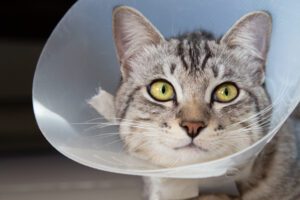Traditional and Laparoscopic Spay & Neuter Options
Here, we’ll explore the differences between traditional and laparoscopic surgical approaches. Making informed decisions about your pet’s health is always important, and we’re here to help you understand your options better. For more detailed information or to schedule an appointment, feel free to reach out to us at University Veterinary Hospital in Shreveport, LA, at (318) 797-5522. Our team is ready to assist you.

Understanding Spay and Neuter Procedures
Spaying and neutering are surgical procedures performed to prevent pets from reproducing, contributing to better health and behavior. The traditional spay (for females) involves removing the ovaries and usually the uterus, while neutering (for males) involves removing the testicles. These are performed through an abdominal incision. In contrast, the laparoscopic method is less invasive, using smaller incisions and a camera to aid the surgery.
Traditional Spay and Neuter Techniques
In traditional spaying, a relatively large incision is made in the abdomen to access the reproductive organs. This allows the veterinarian to have a clear view and ample space to operate. For neutering, an incision is made at the base of the penis to remove the testicles. These methods have been practiced for decades and are well-understood by veterinary professionals. The recovery from these surgeries typically involves at least 7 days of restricted activity and pain management.
Laparoscopic Spay and Neuter Techniques
Laparoscopic surgery, on the other hand, uses modern technology to minimize invasiveness. Small incisions, usually less than an inch long, are made, through which a camera and specialized surgical instruments are inserted. This approach provides a magnified view of the internal organs and allows for precise operation. The smaller incisions typically result in less pain and a quicker recovery period for the pet. However, not all veterinary practices have the equipment or trained staff to perform laparoscopic procedures.
The Benefits of Laparoscopic vs. Traditional Methods
While both traditional and laparoscopic spay and neuter methods achieve the same end goal, they differ in terms of recovery, pain management, and surgical risk.
Recovery Time
Pets undergoing laparoscopic surgery often experience a faster recovery. The smaller incisions heal quicker, and the less invasive nature of the procedure generally means less pain and discomfort. In traditional surgery, the larger incision takes longer to heal, and there may be more post-operative discomfort.
Pain Management
With laparoscopic procedures, pets typically require less pain medication post-surgery. The minimally invasive approach leads to less tissue trauma, which translates into less pain. In contrast, traditional methods, due to larger incisions and more extensive tissue handling, might necessitate more significant pain management.
Surgical Risk and Complications
Both methods carry the standard risks associated with surgery and anesthesia. However, the laparoscopic approach, with its smaller incisions and reduced tissue manipulation, may lower the risk of certain complications like infection and postoperative hernias. Traditional surgery, with its larger wound, might have a slightly higher risk of complications such as bleeding and infection.
Suitability for Different Pets
It’s important to note that laparoscopic surgery might not be suitable for all pets. Factors like the pet’s size, age, and overall health condition will all determine the most appropriate method. Larger or overweight pets, for instance, may be better candidates for traditional surgery due to the challenges posed by laparoscopic techniques in these cases.
Our team at University Veterinary Hospital can help you make the best decision for your pet’s needs. We’ll discuss the risks and benefits of each option and answer any questions you might have.
What to Expect After Your Pet’s Surgery
The veterinarians of University Veterinary Hospital are experienced in both traditional and laparoscopic procedures. We use the latest techniques and equipment to ensure your pet’s comfort and safety. Trust us to provide the best care for your pet’s specific needs.
Post-Procedure Care and Recovery
After spaying or neutering, your pet will need time to recover. We’ll provide detailed instructions for post-procedure care, including pain management, activity restrictions, and monitoring for any complications.
Home Care
Rest is essential for your pet’s recovery. Keep them in a quiet, comfortable space and follow our guidelines for feeding and medication. It’s important to limit your pet’s activity and avoid bathing them until they’re fully healed.
Follow-Up Visits
We may schedule follow-up visits to check on your pet’s recovery. This is a good opportunity to address any concerns and make sure your pet is healing well.
Let’s Discuss Your Pet’s Spay or Neuter Options
Choosing to spay or neuter your pet is a responsible decision that benefits their health and well-being. Whether you opt for a traditional or laparoscopic approach, our team at University Veterinary Hospital is here to guide you through the process. Contact us at (318) 797-5522 for more information or to schedule an appointment.
Recent Posts
About University Veterinary Hospital
UVH has a phenomenal team of veterinarians and specialists available to meet all your pet’s needs. From the moment you walk through our doors, you will be met with friendly faces and warm greetings from our wonderful front desk team, and then ushered into an exam room to meet with your veterinarian. We are deeply invested in your pet’s longevity and happiness, and in your satisfaction.
